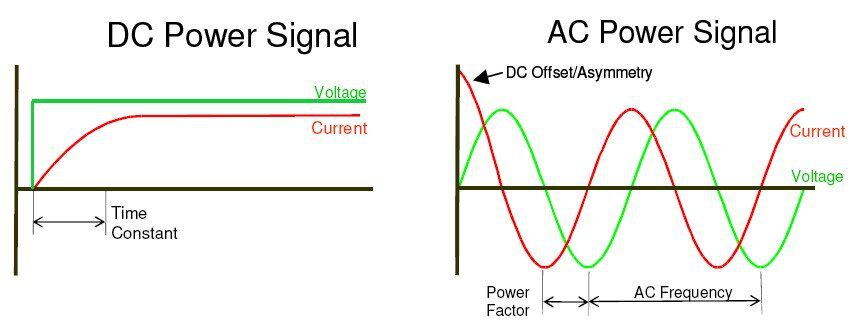What is Direct Current (DC)?
What is direct current?
DC refers to the electric current (which consist of electrons) flowing in one direction. Unlike alternating current (AC), DC does not change its electrical charge and therefore maintains one consistent supply of electricity. As you can see below from the graph, DC is able to provide a constant supply of voltage to power your electronics. This is important for any electrical device that uses a battery as a power source because you do not want your device to constantly switch off and on due to the fluctuating electrons.

Simply put, the term DC is used in reference to the voltage whose polarity (or charge) never reverses. Direct current is often used in low-voltage applications including battery-operated devices.
An ideal direct current supply should always provide a steady voltage and current throughout the entire use of the electronics. Unfortunately, sources such as batteries may only offer a limited capacity thus can only power the device for a given time. To maintain electrical energy at a constant level, most devices use rechargeable batteries to ensure that charge can be replenished accordingly.
Who invented direct current?
In around 1878, inventor and businessman Edison Thomas identified a market for a system which could potentially bring electric lighting directly into a client’s business or house, an opportunity not served by the then-popular arc lighting systems. By early 1880s, Thomas owned his own utility company, Edison Illuminating Firm, in New York City.
It is critical to mention that he basically designed his company to compete with the then established gas lighting service providers. He based his utility on a relatively lower 110 Volts direct current supply to power an incandescent lamp of high resistance which he had invented for the system. Direct current systems could be used together with storage batteries to provide useful load-levelling and backup energy for use during power interruptions. Direct current performed extremely well with electric motors, a position DC held throughout the 1880s.
However, the only disadvantage with direct current power supply is that it operated at 110 Volts from the source of generation to the final destination, a phenomenon that gave it a relatively shorter transmission range. Simply put, it could only serve clients less than a mile from the source.
How does direct current work?
As we previously mentioned, DC electricity typically describes the continuous flow of electrons from a source of negative charges to an area of positive charges via conducting materials such as a metal wire. In simple terms, direct current is the continuous movement of electric charges through a wire.
A good example is the standard battery, electrical devices as well as a conducting wire that runs from the positive end of the source to the negative terminal. To make it easy for you to understand it better, the flow of electricity in a direct current is more or less similar to the flow of water through the hose pipe. Also, a flashlight or torch is a typical example of a DC circuit. Common sources of DC include:
- Batteries
- Thermocouples
- DC generators
- Solar panels
- DC energy converters which rectify the AC
What are some of the applications of direct current?
Thanks to the potential benefits offered by direct current, we have a lot of electrical equipment that employs the use of DC. If you didn’t know, it is used in almost all electronic equipment, automation, electric vehicles as well as in control of electric appliances. Flashlights, computers, tablets, amplifiers and audio systems. However, because the universally available electrical energy is alternating current (AC), appliances use either an external or internal power supply to transform the utility mains into the designated DC for the appliance.
What some of the advantages of direct current?
- It poses relatively fewer risks of shocks, especially for voltages below 48V.
- Studies have proven that most electrical appliances are more efficient when directly powered from a direct current.
- It is relatively more effective, especially if the power leads are less than a hundred feet.
Is direct current dangerous?
Though electricity, whether DC or AC, should be handled with extreme care, direct current is less lethal as opposed to its AC counterpart. There are potentially a lot of reasons why AC is considered less dangerous than DC. In the case of electric shocks, fibrillation is often the most common cause of death.
If you didn’t know, this is a condition where all your heart muscles start moving independently in an uncoordinated manner rather than in a state of coordination. AC’s alternating property has a great tendency to cause cardiac muscles to go into a state of fibrillation as opposed to DC. In this regard, DC can be considered to be milder than AC.
If you’d like to know more, read our article on alternating current vs direct current. Otherwise, feel free to contact the experienced electricians from Gordon’s Powers for all your electrical services.












